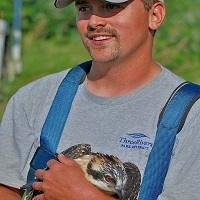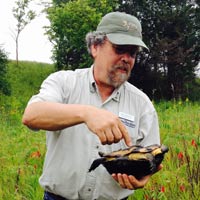Snowshoe Hike with the Wandering Naturalist
Feb. 22 | Eastman Nature Center
Explore the winter woods with the hosts of The Wandering Naturalist podcast! Reservations required.
Feb. 22 | Eastman Nature Center
Explore the winter woods with the hosts of The Wandering Naturalist podcast! Reservations required.
Animal tracking is a fun way to spend time outdoors. Signs from the past help tell us the who, what, where, and when of the animal world.
Tracks are clear indicators that a critter was there, and the more time you spend observing, the more you will learn and see. One way to track critters is by looking for footprints, and snow in winter makes this even easier.
Here are some common tracks you may spot in our parks and surrounding areas.

Steven Hogg is the Wildlife Supervisor at Three Rivers Park District and has been working for the Park District for 13 years. After graduating from the University of Alberta with a degree in Environmental and Conservation Biology, he moved to Minnesota to marry his beautiful Minnesota bride. Steven has always had a passion and dedication for wildlife, even when he was young. This passion is what lead him into a career where he strives for the proper orchestration of research, management, and politics to ensure natural resources and wildlife are given a voice. In his spare time, which there is little of with his three kids, Steven likes to farm, hunt, and fish.
Where do spiny softshell turtles go after nesting on the beach at French Regional Park? How far do softshell, painted and snapping turtles travel in the water? Are they active in winter or affected by water quality? Find out what we learned during the Medicine Lake urban turtle project.
Minnesota is home to seven species of bats, but they don't all approach winter the same way. Read on to learn how bats survive our coldest months of the year.
Now that fall is long past, why are some trees still hanging onto their leaves? Learn what's happening in these trees and why it may be beneficial to them.
Feb. 3 | Mississippi Gateway
At this outdoor-based preschool, children get the freedom to explore and play outside while fostering a lifelong connection to the natural world and environmental stewardship. Registration for the 2020-2021 school year opens Feb. 3.
Ongoing | Multiple Locations
Search for signs of spring with us!
May 14 | Eastman Nature Center
Learn about bird migration as we celebrate World Migratory Bird Day! Take a birding hike with a naturalist, learn how to use binoculars, see how birds are banded, enjoy bird-related games and crafts, watch presentations and more at this full-day festival.
Three Rivers Park District will be conducting a tree removal project in the northeast portion of Elm Creek Park Reserve within the City of Champlin this winter. Contractors have begun work and expect it to take four to five weeks to complete, depending on the weather. The 36-acre site will have most of the existing trees and shrubs removed. This is part of a larger 160-acre Conservation Partners Legacy funded prairie restoration project in Elm Creek Park Reserve.
There are 14 species of frogs and toads in Minnesota, and eight of them can be found in Three Rivers Park District. While all of them stay in Minnesota for the winter, they have very different approaches to surviving the cold.
Many of us have learned that frogs spend the winter buried in the mud at the bottom of a lake. This is partially true for some species, but not for most of the species we find in Three Rivers.
The frogs in Three Rivers have three hibernation strategies: bury on land, freeze in the leaf litter, and spend the winter under water.

John Moriarty is the Senior Manager of Wildlife at Three Rivers Park District and has been with the Park District for 15 years. He has been involved in many of the wildlife restoration efforts and initiated the snake and butterfly efforts. John has led several projects to increase prairie habitat in the Park District. John likes exploring natural areas and looking for all types of plants and animals, but especially turtles.
The arrival of spring brings with it the call of frogs! Learn how these amazing creatures survive winter and find out the truth about frog tongues.
Where do spiny softshell turtles go after nesting on the beach at French Regional Park? How far do softshell, painted and snapping turtles travel in the water? Are they active in winter or affected by water quality? Find out what we learned during the Medicine Lake urban turtle project.
Minnesota is home to seven species of bats, but they don't all approach winter the same way. Read on to learn how bats survive our coldest months of the year.
Imagine a preschool with no walls; a place where children are encouraged to follow their interests. Where math and measurement are practiced in a mud kitchen, and scientific thinking happens naturally while rolling over a log to find insects. A place where the teachers are kind, fun, creative and highly-trained in both early childhood education and environmental education.
No imagination is needed — we have this preschool program right here at Three Rivers!

Megan Kelzenberg is an Interpretative Naturalist at Mississippi Gateway Regional Park. She has worked for Three Rivers Park District since 2008. During this time, she has specialized in teaching early childhood programming throughout the park system, with topics ranging from environmental education to outdoor recreation and cultural history. She also has previous experience working at a nature-based preschool, the US Fish & Wildlife Service, a zoo and several Minnesota-based nature centers. Outside of work, she enjoys gardening, paddling, hiking, home improvement projects, and spending time with her husband and two young children.
We've compiled a list of our 7 favorite activities to help you embrace winter this season. Some of them might be things you've already done before, but a few of them might be new activities you want to try!
Little was known about the winter whereabouts of the monarch butterfly until the mid-1970s. Subtle factors, persistence and a network of people working across borders came together to finally reveal the mystery of the great monarch migration. Read on to learn how Minnesota occupies an important place in the history of monarch research.
Lowry Nature Center turns 50 years old in 2019. Discover how the dream of one man became a reality and how Goodrich Lowry helped shape the future of what is now Three Rivers Park District.
Groundhog Day originally had nothing to do with groundhogs. It started long ago in Europe as the pagan festival of Imbolc marking the start of spring. It then became known as Candlemas by early Christians who believed a sunny day meant more cold weather and snow were coming.
Next, Germans added animals – mainly badgers – to the legend by declaring it sunny if the animals saw their shadows.

John Moriarty is the Senior Manager of Wildlife at Three Rivers Park District and has been with the Park District for 15 years. He has been involved in many of the wildlife restoration efforts and initiated the snake and butterfly efforts. John has led several projects to increase prairie habitat in the Park District. John likes exploring natural areas and looking for all types of plants and animals, but especially turtles.
Ospreys used to be very common in southern Minnesota, but they disappeared from the Twin Cities after World World II. Learn about the program to bring these amazing birds back and how wildlife can survive in an urban area when given the right tools for success.
Did you know there was a time when turkeys didn't exist in Minnesota? Learn all about this Thanksgiving staple in this post from the archive, including how they came to thrive in our area and what to do if they're causing trouble in your yard.
Did you know that the longest snake in Minnesota can be found in Three Rivers Park District? Bullsnake populations have declined in the Twin Cities due to habitat loss, but thanks to reintroduction efforts, they have found a home in Crow-Hassan Park Reserve.